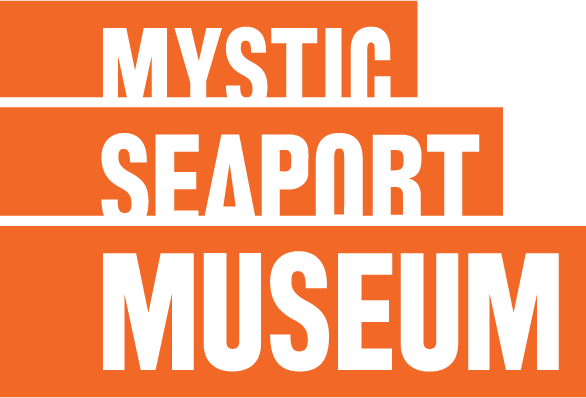In the high season at Mystic Seaport Museum, it’s common to see young visitors walking around the grounds carefully cradling a contraption in their two hands. Upon closer inspection, one can see that it is a boat of some sort, made of wood, with bits and pieces of various shapes and sizes sticking to it, and sometimes including paper, string, and more. Each one is unique, the result of its captain’s artistic eye and glue-gun skill.
 For about 10 years, Mystic Seaport Museum’s Build-A-Toy-Boat shop has churned out thousands of little pine boats crafted by artists ages 4 and up, some modest with just a hull and some coloring, others complex, with spars and masts and rigging and paper sails. By some estimates, there may be close to 100,000 little wooden boats adorning mantle pieces and gathering dust in attics all around the world, made by visitors from late March through October every year.
For about 10 years, Mystic Seaport Museum’s Build-A-Toy-Boat shop has churned out thousands of little pine boats crafted by artists ages 4 and up, some modest with just a hull and some coloring, others complex, with spars and masts and rigging and paper sails. By some estimates, there may be close to 100,000 little wooden boats adorning mantle pieces and gathering dust in attics all around the world, made by visitors from late March through October every year.
It takes a village to keep this activity afloat. For most years, the wood shop in the exhibits department made a batch of hulls and small pieces to get the season started, and then would crank up production whenever supplies ran low during the summer. Interpreter Patricia Willis, who oversees Toy Boats, “would call me up telling me we were low,” said Alan Schaeffer, a fabricator/carpenter in the exhibits department. “I never had a child not have the parts he or she needed to build their boat … but I did run it kind of close a few times.”
In the interest of avoiding panicked phone calls from the Toy Boat Shop and rioting children, Schaeffer took a “big picture” look at the production of all the parts and pieces and decided this year to try an experiment. So his Toy Boat team spent the winter months, one or two days a week, making everything that would be needed for the full season. “I wanted it all to be more efficient,” he said.
Toy Boats opens for weekends-only on Saturday, March 23 – 10 a.m. to 4:40 p.m. It opens daily for the season on June 15. The cost is $5 per boat.
Toy Boats are made from cheap wood, in this case pine roof sheathing board. The supply comes from Arnold Lumber in Westerly, which provides a good price and makes sure there’s a good mix of clean boards and knotty ones. They use about 5,000 board feet in a year.
Cut, cut, and then cut again
The first step in the process is to cut the large board into three equal long sections. Those sections are then run through the radial saw to make the pieces for the boat hulls. The shape of the hull rarely changes – it is similar to the outline of a catboat, and is angled at one end for the transom. The pattern is traced on each block (they still have the original pattern made 10 years ago) and stacked in piles of 20. (One hull change made recently was the addition of a Viking longship hull for Viking Days, a special event that debuted last year and returns this year June 1-2.)
A radial saw then cuts out all the hulls from the blocks, and they are boxed up, 160 to a box. 9,300 hulls have been produced this winter, the only part of the program that is inventoried. The extra pieces are used as pieces for the boat builders, and anything left over at the end of the season becomes kindling for wood stoves used throughout the museum.
Masts are made out of long thin strips of wood, cut at 6-inch intervals. The rest of the parts that go into building a boat are random – small cubes, larger cubes, rectangles, small thin pieces for spars or yards, and an even smaller thin piece that typically becomes crew on the boats.
The team – made up of volunteer Bill Mortenson and Museum staffers Willis, Peter Barres, Schaeffer, and Carson Hill – is winding down, having filled bags and bags with wooden pieces.
Toy Boat Building was started by Jonathan Shay, who retired from the Museum in 2018 after 34 years here. At the time he launched the activity, he was director of both interpretation and exhibits, and so, as he put it, “I didn’t have to ask anyone. I gave myself permission to do it.” He wanted to add a hands-on activity for children that spoke to the Museum’s mission and enhanced the visitor experience.
Popular from Day 1
They opened Toy Boat Building in a tiny alcove behind the Ship Carver building. “Everyone loved it, but the problem was they were all falling apart because we were using regular white glue,” Shay noted. “I realized this had great potential, but not if people had to wait three hours for their boat to dry.”
So glue guns were introduced to the process, and staff made some prototypes for people to use as inspiration, “but it was always so great to see how the visitors would just make it their own way. And theirs were way more interesting than what we did.”
The space was so small that there was always a line out the door to make a boat, so first they tried adding an outdoor space, and then they moved it to the Art Spot building across the way. These days, Toy Boats is located next to the John Gardner Boat Shop.
It’s interesting to note that the original charge for a toy boat was $5, and it remains so today.
One new change for 2019 – toy boat building that doesn’t involve hot glue. Because of the glue guns, children have to be 4 or older to make a toy boat. Schaeffer felt bad about that, and has seen his share of crying toddlers outside the Toy Boat building who aren’t old enough to go in. So this year he is making hulls that have two or three holes drilled in them. The mast pieces fit into the holes (literally a square peg in a round hole) and with a little push, are sturdy as can be and ready for decorating.
“It’s such a great activity,” Schaeffer said. “I think it’s part of the magic of the place, when you’re here your imagination is running and it’s an irresistible activity.”











